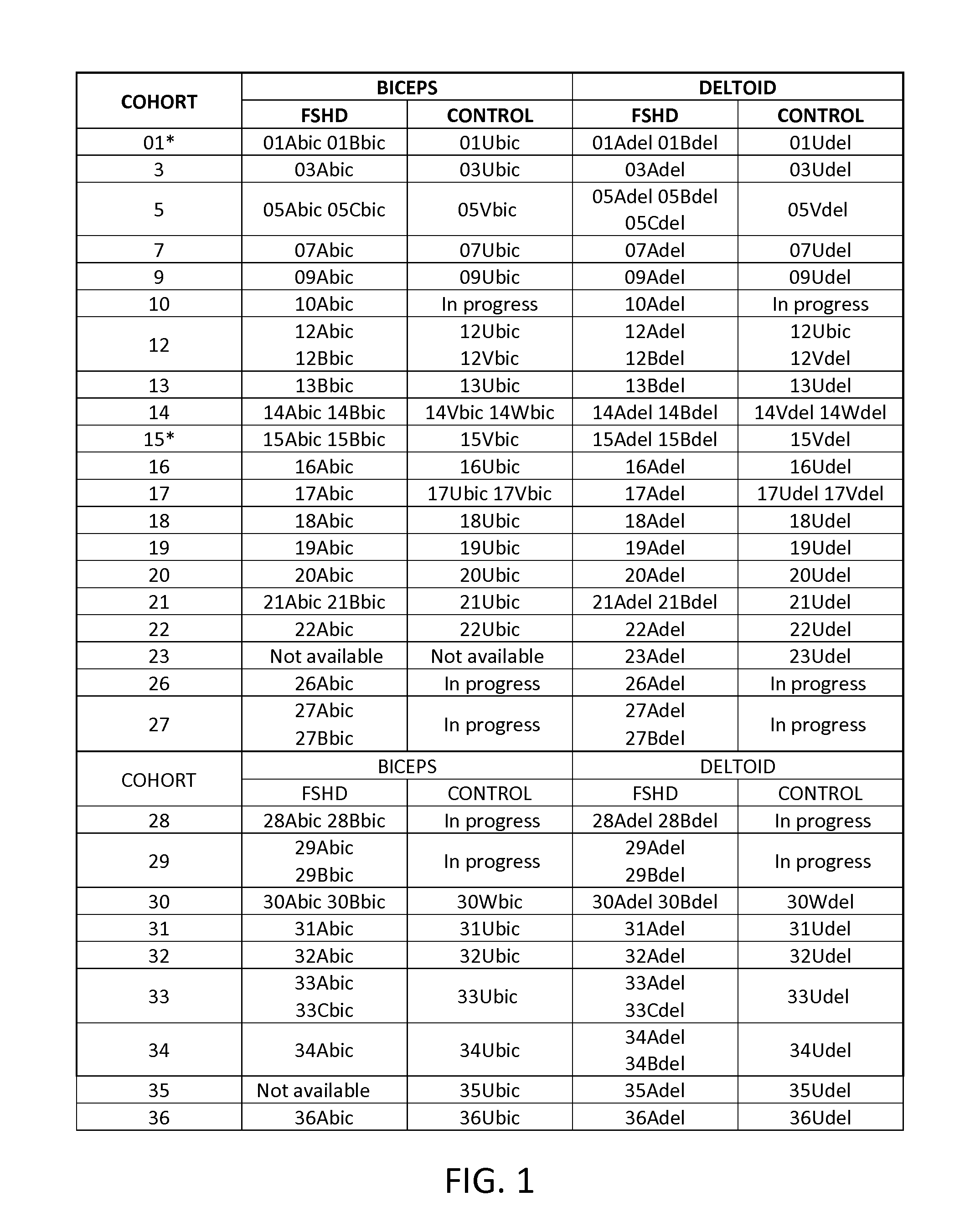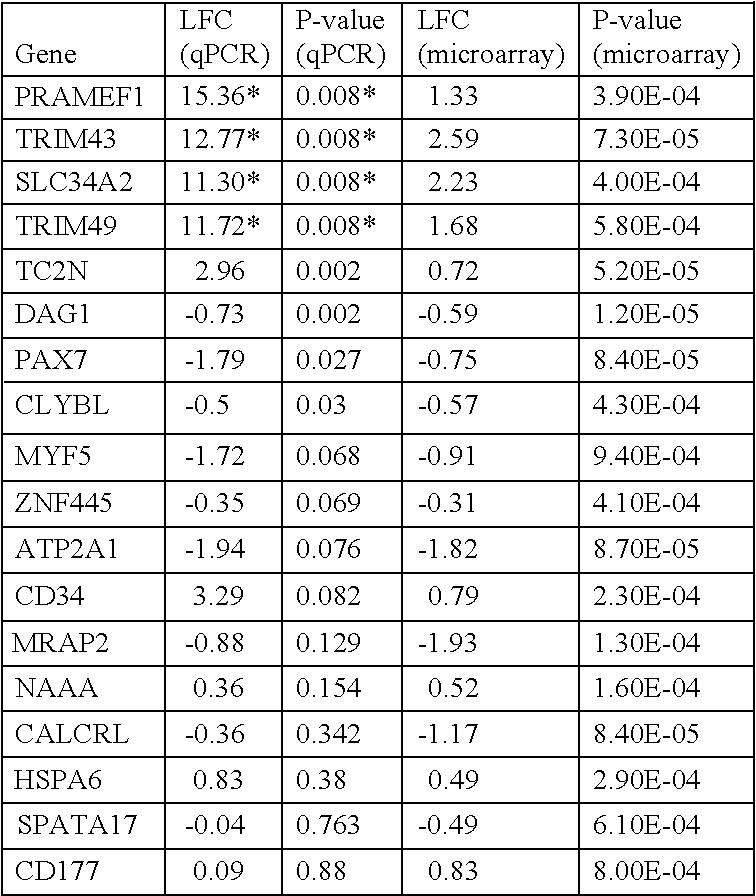Compositions and Methods for Characterizing and Treating Muscular Dystrophy
a muscular dystrophy and composition technology, applied in the field of compositions and methods for characterizing and treating muscular dystrophy, can solve the problems of discouraged clinical trials with novel therapeutics, no effective treatment available for fshd, etc., and achieve the effects of improving biological function, reducing the level of expression, and increasing the level of expression
- Summary
- Abstract
- Description
- Claims
- Application Information
AI Technical Summary
Benefits of technology
Problems solved by technology
Method used
Image
Examples
example 1
Microarray Analysis Identifies Genes that are Differentially Regulated in FSHD
[0206]Open muscle biopsy was performed on both the biceps and deltoid muscles of 6 FSHD affected and 5 unaffected subjects that are first degree relatives of the FSHD affected subjects. Characteristics of the donors are provided in Table 1.
TABLE 1Clinical characteristics of FSHD subjects and unaffected donors.Age atFamilialEnrollmentEcoRI / BlnlDeltoidBicepsDonor*RelationsGender(yrs)AlleleStrength**Strength07AprobandF1829 kb4+ / 5 at 90°full07Umother ofF4934 kb (4qB),fullfullproband53 kb (4qA) 09AprobandF3125 kb 5 / 5 at 45°4+ / 509Umother of 09AF5747 kbfullfull12AprobandM4918 kb4+ / 5 at 90°4+ / 512Usister of 12AF45>112 kb fullfull15AprobandM6728 kb 5 / 5 at 90° 5 / 515Bbrother of 15AM6928 kbfullfull15Vsister of 15AF60107 kb fullfull21BprobandF5934 kb5 / 54+ / 521Usister of 21BF48150 kb fullfull*Donors are designated by cohort (family) number (07, 09, etc.) followed by A, B for the FSHD donors or U, V for the unaffected 1st ...
example 2
A Humanized Mouse Model of FSHD
[0216]Both FSHD- and control-derived myoblasts from multiple cohorts (described in Homma et al., European Journal of Human Genetics (2012) 20, 404-410) engrafted and formed human muscle fibers after 30 days in vivo. All mouse experiments were performed using BBR1 IACUC-approved protocols. Nonobese diabetic Rag1 and IL2rγ null (NOD-Rag1 null IL2r null or RAG, Jax stock number 007799) mice were used as recipients for human cell transplantations. Adult muscle, composed of multinucleated terminally differentiated myofibers, has a very low rate of cellular turnover under normal conditions. However, it has a remarkable capacity to regenerate in response to injury due to the presence of quiescent satellite cells. A regenerating muscle, which is in the process of incorporating newly differentiating cells, provides a favourable environment to receive a cell graft. Recipient tibialis anterior (TA) muscles were injected with 10 μM cardiotoxin to induce a muscle d...
example 3
DUX4-fl Expressing FSHD Cells Engraft
[0218]Five cell strains (described in Homma et al., European Journal of Human Genetics (2012) 20, 404-410) were used for engraftment studies. Recent breakthroughs in the field suggest that DUX4, a gene identified inside D4Z4 repeats, is inappropriately expressed in the muscles of patients with FSHD. The disease could arise though a toxic gain of function. The precise molecular and cellular pathological mechanism involving DUX4 remains to be uncovered. Recent studies described the detection of two DUX4 transcripts, a long form (or full-length, fl) and a short form, and while the role of the short form is still unclear, the long form was specifically detected in FSHD samples, suggesting a central role in the pathogenic mechanism.
[0219]Based on engraftability and expression of DUX4-fl, cell strain selection for engraftment was refined to consist of three strains derived from the biceps of patients affected by FSHD, and three cell strains from corres...
PUM
| Property | Measurement | Unit |
|---|---|---|
| live cell imaging | aaaaa | aaaaa |
Abstract
Description
Claims
Application Information
 Login to View More
Login to View More - R&D
- Intellectual Property
- Life Sciences
- Materials
- Tech Scout
- Unparalleled Data Quality
- Higher Quality Content
- 60% Fewer Hallucinations
Browse by: Latest US Patents, China's latest patents, Technical Efficacy Thesaurus, Application Domain, Technology Topic, Popular Technical Reports.
© 2025 PatSnap. All rights reserved.Legal|Privacy policy|Modern Slavery Act Transparency Statement|Sitemap|About US| Contact US: help@patsnap.com


